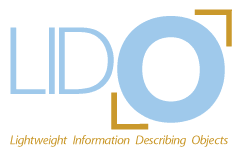LIDO Terminology
The LIDO Terminology is an adjunct to LIDO – Lightweight Information Describing Objects, an XML Schema for contributing metadata to cultural heritage repositories. It complements the LIDO specification with the aim of enhancing the interoperability of object descriptions across different collections. This is accomplished by introducing controlled vocabularies for certain elements and attributes within the LIDO XML Schema.
Addressing the Linked Open Data paradigm, the LIDO terminology makes each of its terms referenceable through a Uniform Resource Identifier (URI). Using URIs from the terminology.lido-schema.org namespace as values for type attributes and element type refinements is considered the current best practice. Data providers are encouraged to follow this practice so that local metadata can be transformed into a future-proof application of the LIDO XML schema. This enables more reliable processing of LIDO data on the part of metadata aggregators and portal providers and a more satisfactory experience for users of search facilities for cultural heritage objects.
All vocabularies from the LIDO Terminology can be searched and browsed in xTree.public. A LIDO Term is identified by a URI and has at least a preferred label and a definition, both in English. It can also have preferred labels in other languages, alternative labels, mapping relations, and a scope note. Wherever possible, the definition is based on or refers to authoritative sources (e.g., CIDOC Conceptual Reference Model, Categories for the Description of Works of Art, or the Art & Architecture Thesaurus).
LIDO Vocabularies are quite different in size and specificity and may be extended in the future. While many vocabularies are simple lists of descriptors (e.g., types for Identifiers), some are structured in a concept hierarchy (e.g., values for Event Type). The latter allows indexers to choose a specific term, if known, or a more general term otherwise.
A URI from the LIDO Terminology is a fully qualified statement in itself, meaning that it can be used without any textual equivalent. Application programs use URIs as keys to underlying information, typically rendering them as a term in a particular language, or for arranging data elements on the user interface.
Many vocabularies from the LIDO Terminology provide values for LIDO type attributes. There is a distinction between a LIDO Term that qualifies the “type” of the LIDO element, and a “descriptor” from a different vocabulary that represents the actual data for information retrieval. To illustrate this, consider a LIDO element <termMaterialsTech> carrying a type attribute http://terminology.lido-schema.org/lido00132 (“Material”), saying that the descriptor contained in the element should be used, e.g., for a “Materials” search facet. Here, an appropriate descriptor could be, e.g., http://vocab.getty.edu/aat/300011914 (“wood (plant material)”).
The XML record in LIDO v1.0 would then look as follows:
<lido:termMaterialsTech lido:type="http://terminology.lido-schema.org/lido00132"> <lido:conceptID lido:type="http://terminology.lido-schema.org/lido00099">http://vocab.getty.edu/aat/300011914</lido:conceptID> <lido:term lido:pref="http://terminology.lido-schema.org/lido00169" xml:lang="en">wood (plant material)</lido:term> </lido:termMaterialsTech>
The XML record in LIDO v1.1 using RDF namespaces would look as follows:
<lido:termMaterialsTech lido:type="http://terminology.lido-schema.org/lido00132"> <skos:Concept rdf:about="http://vocab.getty.edu/aat/300011914"> <skos:prefLabel xml:lang="en">wood (plant material)</skos:prefLabel> </skos:Concept> <lido:term lido:addedSearchTerm="yes" xml:lang="de">Holz</lido:term> </lido:termMaterialsTech>
LIDO Terminology LOD Interface
- RDF Representation
- URI Syntax
- Content Negotiation/Serialization
- Service Description
- URI Resolution
- Use in a Web Browser
Web interface: http://terminology.lido-schema.org/
SPARQL: http://terminology.lido-schema.org/sparql
